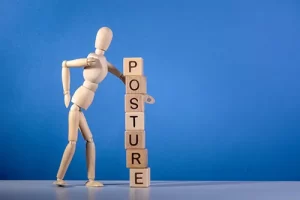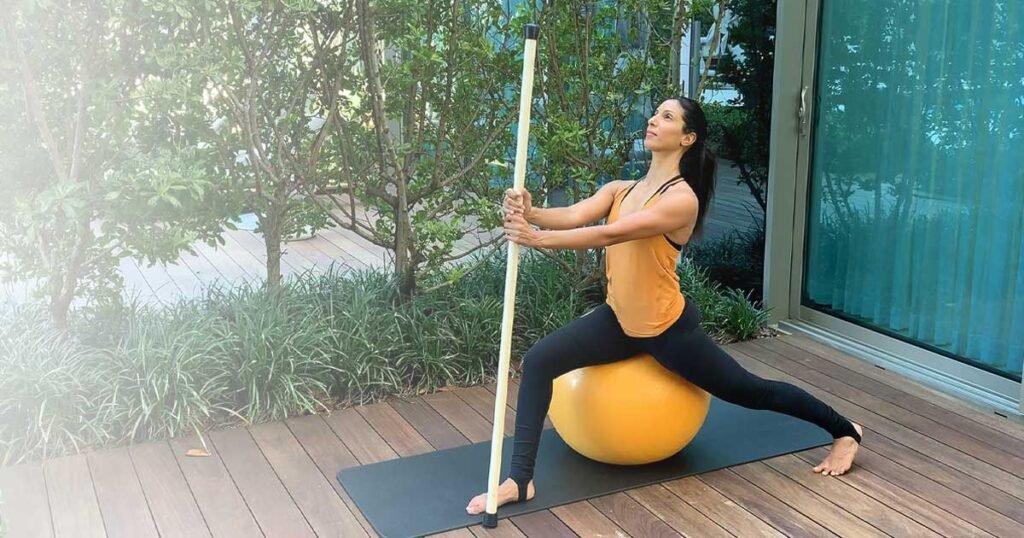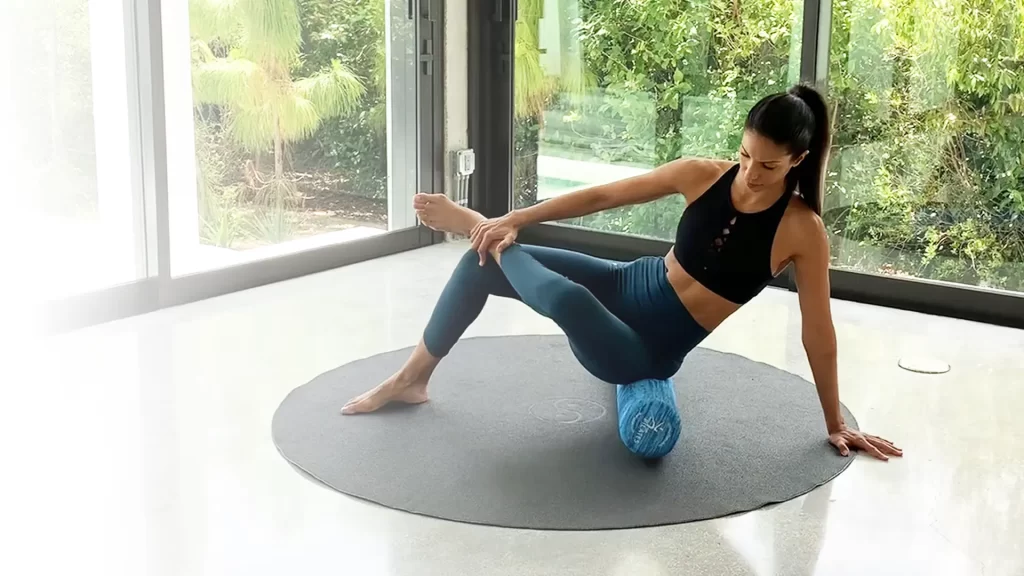When focusing on exercises for posture correction, the objective is to effortlessly stabilize the body by fostering a healthy range of motion, muscle strength, and endurance. The Swiss ball emerges as an outstanding tool for reaching this target, making it my top choice for engaging in posture correction exercises to enhance overall posture.
But before we jump into what we’re here for: exercises for posture correction – lets talk a little about what is posture, what exactly does it mean “good posture” “and how we can improve our posture.
Embark on a transformative 20-minute journey with me through this follow-along YouTube video, where we’ll use a Swiss ball and a stick to enhance your posture.
What is Posture?
For most people, movement is considered as something dynamic, and posture as a static position with no movement. However, perceiving posture as an independent factor that has nothing to do with the body movement system is wrong.
Movement is the basic and main functionality of the skeleton and muscle systems. All the static positions our body is capable to hold are only part of this basic function called movement and posture is derived from it. As Sherrington (1906) said: “posture follows movement like a shadow.”
Roaf (1978) even defined posture as the body’s “temporary position” in preparation for the next position. And that is why static standing is not “real” posture. Our human body is very dynamic and cannot be defined with one posture. It can be positioned in many ways and sometimes hold in one of them for prolonged time.

What is a good posture?
Generally speaking, good posture refers to the proper alignment of your body while sitting, standing, or lying down. It involves maintaining a position that places the least amount of strain on your muscles, ligaments, and other supporting structures. Good posture not only promotes physical health but can also reduce pain and enhance your overall appearance and confidence.
Good posture may be more clear to the eye when we’re standing still in an upright position, but as you understand by now, it’s beyond that. The meaning of the word “posture” is how we hold our whole body or part of it in different positions and how we move it from one position to another.
If you used to poor posture habits, you might feel a little uncomfortable at first by trying to maintain good posture. However, with practicing good exercises for posture correction it becomes more natural and can lead to reduced discomfort, improved breathing, enhanced circulation, and a healthier spine. Regular exercise, particularly those that strengthen your core, back, and postural muscles, can also contribute to better posture.
How to improve posture?
Heredity, age, gender, environmental conditions, emotional state and physical activity are the main factors affecting movement and posture. These should be in consideration when starting to work on improving posture.
A real improvement in one’s posture has to start with awareness and the willingness to do the work; physically and maybe even mentally emotionally. When speaking about posture that is not a congenital defect, but rather something that has developed over the years, it is known that the emotional state can affect greatly. Feelings of depression, anger, stress…
On the physical side, when working to improve our posture it’s important to first identify what’s tight and what’s weak in our body. Which muscles need to be more stretched and which ones need more strength work. In most cases the tightness is in the neck, chest, lower back and hips. The weaker areas are usually the upper back, the erectors of the spine and the glutes. I’m not saying you shouldn’t stretch and strengthen the rest of the body, but with postural disorders, especially those with hunched back, rounded shoulders and forward head posture, the focus is usually in these areas.
I highly recommend seeing a professional physical therapist for a thorough assessment to better understand of the length-tension imbalances in your body. Then you’ll know exactly which muscles need to be stretched more and which ones need strength work.
Exercises for Posture Correction
There are many exercises for posture correction you could do with the Swiss ball. Here I chose to add a stick to some of the movements for support and guidance. This could be any stick you may have at home. It doesn’t have to be a special mobility stick.
Exercise #1: Chest Stretch
Why? To stretch your chest muscles and open up the front of your body. This area tends to be tight and short for those with rounded shoulders and hunchback position (Kyphotic back).
Starting Position: From kneeling position, place one hand on the floor and other arm and shoulder resting on the ball.
Movement: Drop your body down toward the floor, allow your shoulder blade to move toward your spine. You should feel a gentle stretch at the front of your shoulder and chest muscles. Hold the stretch for 10-30 seconds, then release for 10-30 seconds. Repeat 2-3 times on each side.
Key Points: keep your shoulders and torso parallel to the floor.
Exercise #2: Lat Stretch
Why? To stretch your big back muscles, the Latissimus Dorsi. Another muscles that tend to get tight and short in a kyphotic posture.
Starting Position: From a kneeling position, place the back of your hand on the ball right in front of you.
Movement: Roll the ball out in front of you with long arms until you feel a gentle stretch along the sides of your body. You can gently move back and forth or simply hold the stretch. You can rest your forehead on the ball. Hold it for 10-30 sec. Then release for 10-30 sec. Repeat 2-3 times.
Key Points: Keep the palms of the hands facing upward. make sure not to hyper extend the lower back. Slightly tuck under the tailbone so it’s facing down to the floor (posterior pelvic tilt), just make sure you’re not rounding the upper back. This tiny movement will help you to better feel the stretch in the targeted muscle – Latissimus Dorsi.
Exercise #3: “Climbing” Back Extension
Why? To open and stretch the front of the body and to mobilize the spine also as a prep to the following exercises.
Starting position: Laying prone on the ball and hold the stick vertically in front of you. The bottom end of it is on the floor. Bend the knees slightly with your feet wide apart. You can also lean your feet against a wall for more stability.
Movement: Extend the back and lift up the chest as you walk your hands up the stick. Go as high as you’re comfortable. Then walk your hands down to lower the chest over the ball, back to starting position.
Key Points: Lean on the stick for support. Feel a gentle stretch to the front of the body: abdominal wall and maybe hip flexors as well.
Exercise #4: Prone Shoulder Extension
Why? To strengthen the upper back, which tend to be weak especially for those with a hunchback position (kyphosis).
Starting Position: Laying prone over the ball with the knees on the floor. Feet can be against a wall for more stability. Hold the stick horizontally with wide arms, between your thumbs and index fingers (palms of hands facing each other).
Movement 1: Bend the elbows to bring the stick close to the chest. Then reach the arms long forward over the head. Bending and straightening the arms.
Movement 2: With long arms forward – lower and lift the arms; lower the stick down to the ground, then lift it up towards the ceiling.
Key Points: keep shoulders down away from the ears. Engage the glute muscle and press your pubic bone gently against the ball. Avoid hyper-extending the lower back.
Exercise #5: Prone Hip Extension
Why? To strengthen the glute muscles, a big player in postural correction work.
Starting Position: Laying prone over the ball. Place the hands on the floor in front of the ball, legs in a “diamond” shape with your feet off the ground.
Movement: Lift and lower the legs, moving from the hip joints.
Key points: Lift your legs up as high as you can without hyperextending the lower back. You can lean on your hands or on your elbows if more comfortable.
Exercise #6: Horseback Riding
Why? To work the inner thighs and core muscles.
Starting Position: Sit on the ball in a “rinding” position. Ball between your legs. You can use the stick here for support right in front of you, or hold it horizontally for added challenge.
Movement: Press the ball between your thighs, engaging the inner thighs and release. 15-20 reps. x2-3 sets. Progression: Hold the stick in your hands: lift the arms up over head as you press on the ball, then lower the arms down as you release.
Key points: maintain a long neutral spine with the pelvis slightly tucked under (posterior pelvic tile).
Exercise #7: “Swimming”
Why? Integrating stability and muscular work of your back extensors, core, glutes.
Starting Position: Laying prone over the ball. Hands and feet down on the floor.
Movement: Lengthen and extend opposite arm and leg off the floor. Alternate sides.
Key Points: When alternating sides – try to suspend both arms and legs up in the air. Move slow and controlled.



